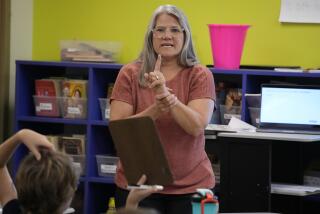Multiply Kids’ Curiosity With More Resources
- Share via
To this parent and engineering professor, sometimes the news seems to be all bad. The results of the recent Third International Math & Science Study indicate that U.S. 12th-graders, compared to their peers around the world, were below average in every category of science and math tested, and they were dead last in physics.
These results and those of other similar tests and surveys suggest that many of our citizens are scientifically illiterate--this in an economy that increasingly is driven by technology. Qualified U.S. students are declining to enter doctoral programs in science and engineering, forcing our graduate schools to recruit overseas just to fill the demand for employment within the United States.
And yet, as a professor in materials science and engineering at UC Irvine, I’ve witnessed how today’s top scientists and engineers are using clay, sand and other common earth materials to benefit mankind in wondrous ways that were unheard-of just a generation ago. Ceramics, perhaps the oldest material known to man and with a basic composition that can be found in our backyards, are now key ingredients in exciting new applications in the fields of medicine, aerospace, environmental protection, automotive technology, fiber optics and military defense.
In medicine, for example, doctors recently have made encouraging strides in fighting deadly liver cancer by using tiny glass beads to deliver large but very localized amounts of radioactive treatment to diseased tumors. This medical breakthrough is a major step forward from traditional cancer treatments, because the glass beads are sent directly into the body to treat the specific diseased area, leaving the surrounding healthy tissue undamaged.
Ceramics also are being used to repair and replace human heart valves, hips, fingers, knees and other joints because of their strength, wear resistance and ability to encourage bone growth and tissue formation.
Using common sand or clay and transforming it into a ceramic “miracle” material is an example of what makes science so fascinating for me today. Sadly, however, not enough of our young students view the science and engineering fields as exciting at all, as reflected by their low math and science aptitude scores. These low scores are likely a combination of too little emphasis on science and technology in our schools and a general lack of interest by the students themselves.
Yet the current scientific “miracle” makers use on a daily basis the basic math and science skills they learned in high school and college. Their technological innovations are a key reason why the United States is currently on top in a highly competitive, global marketplace.
But, according to the American Ceramic Society and other engineering-related organizations, a national shortage of engineers is looming. Fewer and fewer youngsters are entering science- and math-related fields.
In response to this crisis and to help spark student interest in the sciences and engineering, faculty, staff and students from UCI have mobilized to offer extensive outreach activities.
For example, last fall, faculty, staff and students, along with other Southern California-area members of the American Ceramic Society, conducted interactive scientific demonstrations for more than 800 public school students at the Science Library at UCI.
These demonstrations, part of the “Magic of Ceramics” exhibit on display at the library during the same time, allowed students to participate in hands-on activities designed to illustrate how fun science and engineering can be.
Complementary visits to the UCI School of Engineering laboratories, where students glimpsed the future of earthquake engineering, robot design and nano-scale technologies, were used to pique their interest in the material engineering challenges of today.
This summer, at a two-week Chemistry Institute for eighth-grade students, UCI faculty and graduate students worked side by side with junior high school students in laboratories exploring the mystery of how nature creates amazing ceramic structures such as seashells.
Are these activities labor-intensive for UCI faculty, staff and students? Yes. Time well spent? Absolutely yes.
To raise the scientific literacy rate of our nation, we all simply must devote the resources necessary to keep our students interested in the sciences and engineering as attractive career paths. There is too much at stake if we do not, because the students of today are the next generation of miracle makers.






